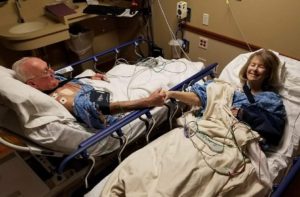
Robert and Carol Zeller seem to have taken to heart the ‘80s U2 song, “Two Hearts Beat as One.” In 2017, the Zellers, who have been a couple for 48 years, developed similar symptoms of congestive heart failure (CHF), a condition resulting from a weakened heart muscle. Both were experiencing shortness of breath and tired very easily. On March 21, they checked in to Elmhurst Hospital together to do something about it.
After a series of cardiac tests, their doctor, John Cahill, MD, an independent cardiologist on the medical staff at Elmhurst Hospital, gave both a diagnosis of a condition is called dyssynchrony. It means the heart’s opposing walls contract at different times instead of together, as if your car’s spark plug timing was off – the vehicle would run, but not well. Many a time people tend to take symptoms and uneasiness lightly. This can be dangerous as it might be a sign of a possible heart condition. Therefore, it might be advisable to visit a heart doctor Johns Creek or in the vicinity and get diagnosed for any heart problems.
Coming back, Dr. Cahill referred the Zellers to cardiac electrophysiologist Cash Casey, MD, another independent physician on the staff. Dr. Casey scheduled the Zellers to have the same procedure – implant of a biventricular defibrillator – on the same day, back-to-back. This is just one of many defibrillators that are currently used across the medical world. You may wish to check out the options here for further information.
“This device serves three functions,” said Dr. Casey. “It can control the heart rate, synchronize the contractions of the left and right ventricles to improve the heart’s pumping ability and, if needed, serve as a defibrillator to shock the heart, saving the patient from sudden cardiac arrest.” Not many people have a defibrillator, let alone a biventricular defibrillator. However, having a defibrillator somewhere can really make a difference to someone who needs it. If you are considering buying this medical equipment, but are unsure about what to get then you can take a look at something like the trusty Defibtech Lifeline defibrillator here.
On the day of the Zellers’ procedures, two of the couple’s daughters were on hand: Kim Annoreno and Sherrilynn Smith. When 79-year-old Robert’s 90-minute procedure was over, he was wheeled out of the post-procedure room. He was awake enough to say “Hi” when the gurney detoured to where Carol, 74, waited her turn on a gurney in the holding area. The staff put the beds next to each other, but in opposite directions, so they could see and embrace each other before Carol went into the operating room. It was a very touching moment, according to Dr. Casey.
Hospital rooms across the hall
When both were transferred to the inpatient floor, they were in rooms across from each other. There was a prescribed four-hour post-procedure wait to begin walking. But soon after that, Annoreno said her mom and dad were on a frequent loop of visits between the two rooms, with one of the daughters at their side. In fact, both patients’ nurses had to go to Carol’s room because that’s where the Zellers were spending all their time.
“Nurses are used to tending to their patients in their private hospital rooms,” said Dr. Casey. “In this case, it was understandable that they wanted to be together even though they were both post-operative patients assigned to their own private rooms.”
“It was something to see them in a hospital room wearing the same gowns and slippers and the same white holder for their monitor,” said daughter Kim. “Then on the next day, they were leaving the hospital looking like the picture of health, he in his cowboy boots and she, looking as put together as ever.”
“I definitely breathe better and I’m not tired all the time,” Carol said following her procedure. It’s a wonderful thing. I can tell my husband is better too, from the way he breathes and he seems to have more energy.”
The Zellers’ improvement has been a big relief to the daughters, too.
“It’s like their chests suddenly have built-in paramedics.” Kim said.
“It was sweet how the couple supported each other throughout this process,” said Dr. Casey. “Now they can continue, stabilized in their congestive heart failure and protected if something bad should happen.”
To find out if you’re at risk for heart disease, visit eehealth.org/heartaware or call 877-45-HEART to schedule a heart scan.


